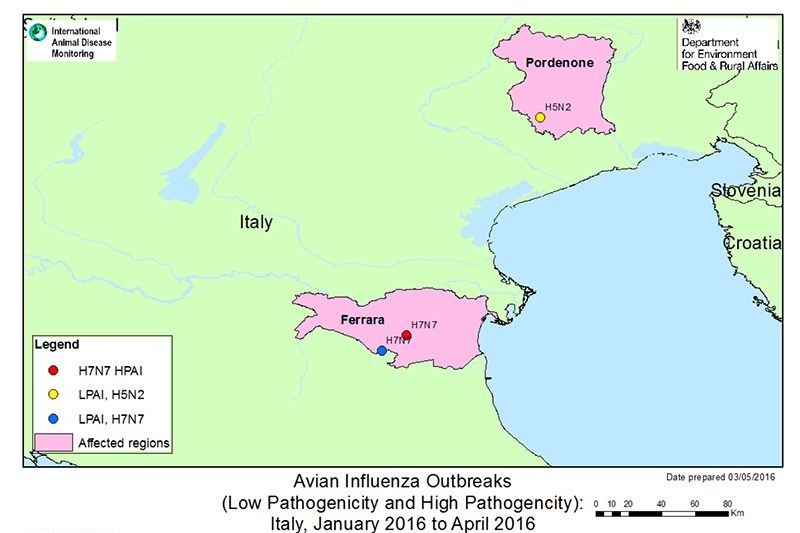
Highly pathogenic avian influenza has been confirmed in a commercial layer flock in northern Italy.
A total of 17,000 birds have been lost in t outbreak in the Ferrara region of the country.
Some 600 birds died in the outbreak; the rest were culled following confirmation that avian influenza was involved.
The OIE (World Organisation for Animal Health) has reported that the affected birds were free range or organic layers.
Italian authorities say that the outbreak involved a highly pathogenic H7N7 strain of bird flu. This is the same strain involved in the outbreak in Lancashire last year.
Nearly 200,000 birds were lost – a mixture of cage and free range hens – when avian influenza hit Staveley’s Eggs near Preston in Lancashire.
H7N7 was also involved in an earlier outbreak in Hampshire, although this case – at a commercial chicken breeding farm at Upham in the Meon Valley – was a low pathogenic version.
Defra’s Animal and Plant Health Agency (APHA), which has issued a statement about the new case in Italy, says there have been a number of outbreaks of H7N7 in Europe in the last two years.
"H7 viruses have been detected in outbreaks in poultry several times in Europe in the past few years where an incursion of LPAI has mutated to HPAI," said the statement, which was issued by Professor Ian Brown and Dr Helen Roberts.
"This is more frequently detected in poultry layer farms, which may be due to a combination of the age of the birds and other risk factors arising from the nature of the production system, such as increased frequency of contact with the environment and increased indirect contact with wild birds affecting the selection pressure for mutation to HPAI."
High path incursion of the virus
APHA said it was not yet clear whether the Italian case started as low path AI and mutated to high path, although this was most likely.
"The most probable explanation is that there has been an undetected incursion of LPAI H7N7 virus which has mutated to HPAI as it spread through the flock," APHA said.
"The Italian authorities suggested that very sudden onset of increased mortality and drop in egg production, may suggest a high path incursion rather than a mutation from low path.
"If this is a wild bird strain of H7N7 which causes HPAI infection in poultry, as opposed to a mutation from an LPAI strain to an HPAI strain in poultry, then this would be concerning and novel."
"However, it will be important to await full laboratory and epidemiological findings before drawing firm conclusions.
"It is possible there is an as yet undetected H7N7 HPAI virus circulating in poultry or captive birds elsewhere, which has not caused clinical signs."
"If this was the case, this would reinforce the need to enhance surveillance through early reporting systems where signs were not suggestive of AI. This would involve the use of testing for exclusion schemes like the one used in the UK.
Reminder to maintain high standards of bio-security
"We would like to remind all poultry keepers to maintain high standards of bio-security, remain vigilant and report any suspect clinical signs promptly and, in addition, using the testing to exclude scheme for avian notifiable disease where appropriate for early safeguard."
APHA said it would continue to monitor developments in Italy. Meanwhile, they said the risk level for the UK remained low, although it was heightened.
The OIE said that restriction zones had been put in place around the affected premises in Italy.
A protection zone of three kilometres and a surveillance zone of 10 kilometres had been established around the farm, according to a notification report, which was based on information provided by the chief veterinary officer in Rome.
APHA said that two other cases of AI had been reported in Italy shortly before this latest case.
Both involved low path bird flu. One was a case of H7N7 amongst ornamental birds. This was also in the Ferrara region. The other was an outbreak of H5N2 at a poultry breeder unit in Pordenone.
APHA said that Italian authorities had reported the low path outbreaks as "phylogenetically distinct" from the latest high path outbreak on the Ferrara layer unit.
The full assessment report can be read here.
